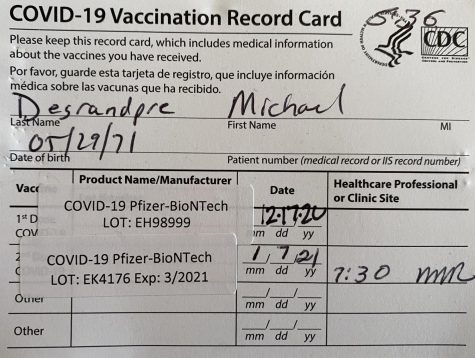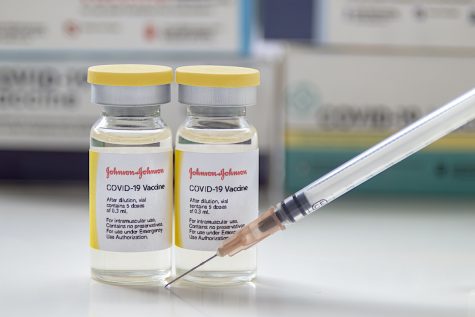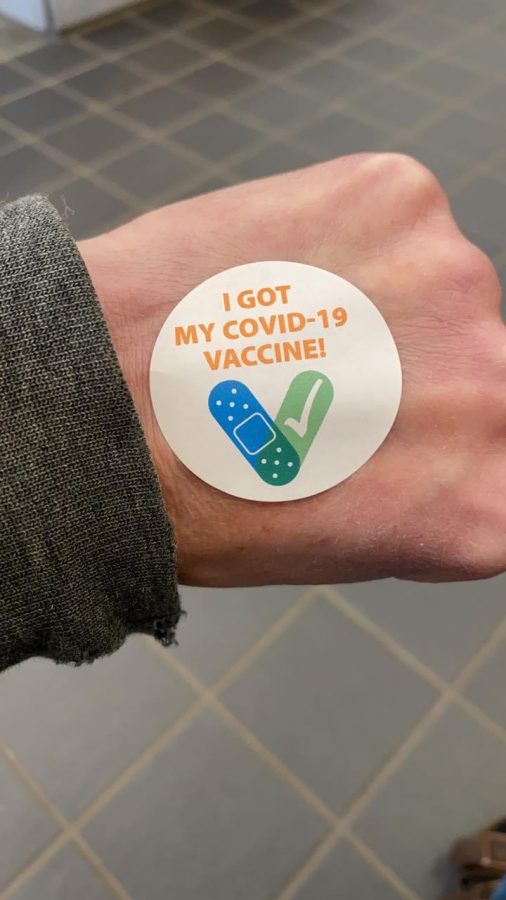Which Covid Vaccine is the Best?
Everything you need to know about the three most popular vaccines.
Local teacher at Lafayette High School, Elizabeth Wathen, recently received her second Moderna shot.

As of right now, the three most popular Covid vaccines are as follows: Pfizer, Moderna, and Johnson and Johnson. The two vaccines that are very similar are Pfizer and Moderna, while Johnson and Johnson is relatively new and varies in a lot of categories. I’m not going to go and tell you that one vaccine is better than the other, considering that I am not a medical professional, but I am going to give you all of the information you need to know to determine your own decision in which vaccine you would be your preference.

Firstly, there is the Pfizer vaccine, which is for people who are 16 years of age or older. It’s a double dose vaccine, the first one being the primary dose and the second one being the booster shot, with 21 days in between shots. The Pfizer vaccine currently has a 95% efficacy rate at preventing symptomatic Covid infections after two doses. Each dose of the Pfizer vaccine is 30 micrograms, and side effects are much more common after the second dose is taken. So far, it appears that this vaccine is equally protective across all age groups and racial/ethnic groups. The Pfizer vaccine can be shipped and stored for up to two weeks in a temperature between -13 degrees to 5 degrees Fahrenheit, and after thawing a vial of the Pfizer vaccine, it must be used within five days. Local Williamsburg medical professional Michael DeGrandpre, PA-C, received the Pfizer vaccine quickly after it first came out and only good things to say about it. He works at Sentara in the Emergency Department and got his second vaccine in early January, “I still haven’t contracted Covid since the vaccine, so it must be doing it’s job.” He went on to say that he did not experience practically any side effects after taking the first or second vaccine, although it has been found that everyone has different reactions to the vaccine.

Next up, we have the Moderna vaccine, which is for people who are 18 years of age or older; although, they are currently testing for minors between the ages of 12 and 17. Similar to the Pfizer vaccine, it is also a double dose vaccine, but the wait time between the two doses is a little bit longer at 28 days. The Moderna vaccine has a slightly lower efficacy rate compared to the Pfizer vaccine at 94.1% for preventing symptomatic Covid infections after two doses. A single dose of the Moderna vaccine is 100 micrograms, but it does not seem to do any better of a job than the Pfizer vaccine, which is at just 30 micrograms per dose. The side effects of the Moderna vaccine, analogous with the Pfizer vaccine, are more common after the second dose. Just like Pfizer, Moderna appears to be equally effective for all ethnic/racial groups; however, the efficacy was found to be slightly lower in people 65 years of age and older, but the company came out and said that there were fewer cases in the trial for that age group, which is why the numbers seem lower. It must be shipped at -4 degrees Fahrenheit, but a vial of the Moderna vaccine is stable for 30 days at fridge temperature and at room temperature for 12 hours.
Like many Virginia teachers, Elizabeth Wathen recently receive her second Moderna shot for returning back to the classroom, with the hopes of staying. Her experience with the side effects of her vaccine were much different compared to Mr. DeGrandpre, who took the Pfizer vaccine. She suffered “pure misery” for the first 48 hours, with the “worse headache and fatigue” of her life, claiming to have slept for 20 hours straight. She said the pain gradually went away over the coarse of about four days and it began to feel like she was recovering from the flu. I must reiterate that everyone experiences side affects very differently, we can see that here, how Mr. DeGrandpre felt close to nothing, while Mrs. Wathen went through some of the worst symptoms of the virus in an extreme manner.

Finally, the Johnson and Johnson vaccine, which is for people who are 18 years or older, and they are not currently testing for younger children. The big difference with the Johnson and Johnson vaccine is that is is a single dose vaccine, so there is no wait time in between shots because it’s a one and done kind of deal. In a multi-country study, the Johnson and Johnson vaccine was shown to be 66% protective against moderate to severe Covid infection, but more importantly, the vaccine in 85% effective in protecting against severe disease. The convenience of the J&J vaccine is significantly better in comparison with the other two vaccines. It can can be stored for up to three months at the temperature of a regular refrigerator and for 12 hours at room temperature before the vial is punctured. After the vial is punctured is can be stored in a fridge for six hours or at room temperature for two hours. Something very critical for the J&J vaccine is that is was being tested during the rise of new variants of Covid around the world, while both the Pfizer and the Moderna vaccines were tested before the new variants emerged. Unfortunately, it has been reported that there will be no substantial number of the Johnson and Johnson vaccine until April.
These three vaccines all have their pros and cons, so it’s really just about what fits you best. However, I must say, that if you have an opportunity to get any of these shots I would take it with gratitude and be thankful to be able to start what hopefully will lead to a decrease in cases and the return to a world of somewhat normalcy.




